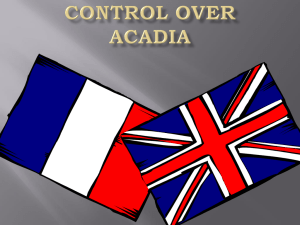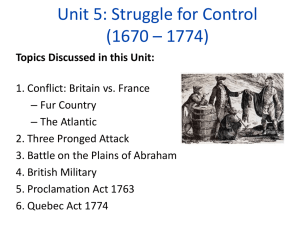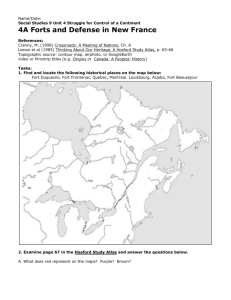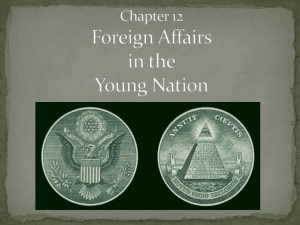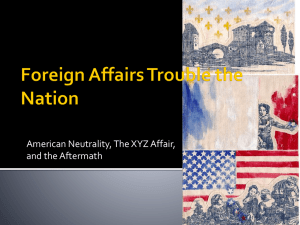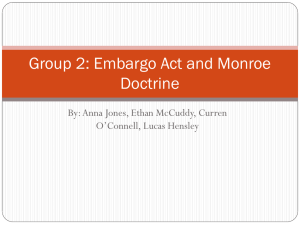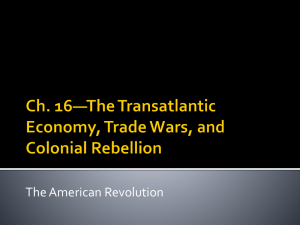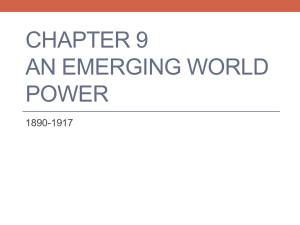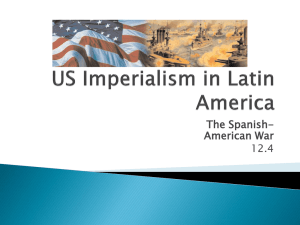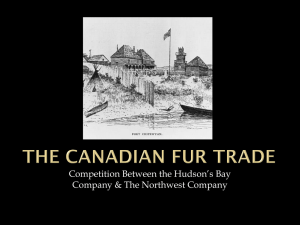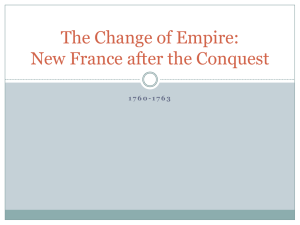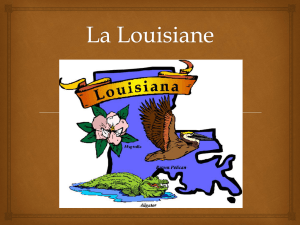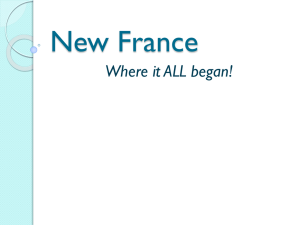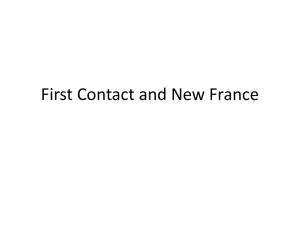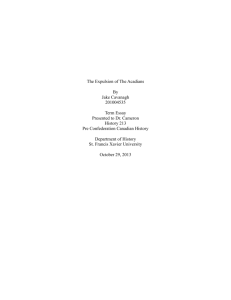The Struggle to Control North America
advertisement
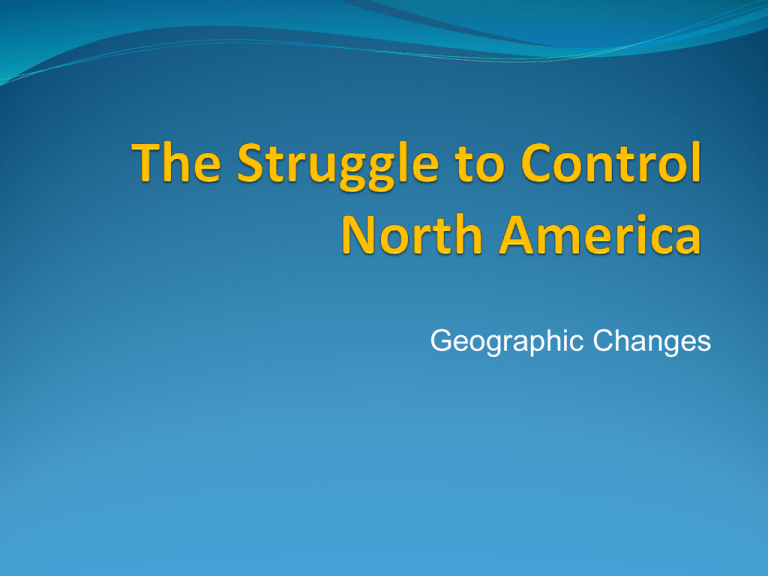
Geographic Changes WAR continues Between 1688 and 1763 a series of wars were fought between France and Britain. These battles were over Land, Wealth & Power and were fought in Europe & North America had effects in Europe & North America was settled with a. Peace Treaty. 1. War of the League of Augsburg (1688-97) Back story (In Europe): Leading up to the War of League of Augsburg (9 year war), King Louis XIV of France had emerged European wars as the most powerful monarch in Western Europe and conquered far-reaching territories. Many European countries were worried about France’s aggressive power and decided to join together to form the “Grand Alliance” to stop French expansion. North American War: King William’s War Peace Treaty: Peace of Ryswick Result: End to British-French Hostilities 2. War of Spanish Succession (1702-13) Back Story (In Europe): The War of the Spanish Succession was a war to gain the Spanish throne for Louis’ family. The previous king had actually chosen Philip (Louis XIV’s grandson), and his wishes might have been respected had Louis promised to open Spain to trade and not unify France and Spain under one ruler. Since he didn’t agree to do so, the Grand Alliance declared war on him in 1701. Louis was defeated, but at the Peace of Utrecht in 1713 he still was able to secure the throne for his grandson though he couldn’t unify the country and had to open Spain to trade. 2. War of Spanish Succession – Pt. 2 (1702-13) North America War: Queen Anne’s War Reason for War: Unification of France and Spain (Disturb the Balance of Power) Result: Treaty of Utrecht settled the dispute Treaty of Utrecht, 1713 Spain’s dominions are broken up and dispersed: Gibraltar and Minorca (island) goes to British. Sardinia goes from Spain to Italy (Piedmont) The Spanish Netherlands (today’s Belgium) goes to the Austrian Netherlands. Spain does retain South America. In Canada, Newfoundland and Nova Scotia go to Britain. British greatest winners at the treaty. 3. Seven Years’ War (1756-63) Back Story (In Europe): There was a continual struggle between France & Britain in N. A. This is a war that put Prussia/Britain against France and the Holy Empire and is the 4th colonial war that happened between France and Britain: • It was an Imperial War • This war was fought on both continents. • The war fought in North America is called the “French and Indian Wars” and was fueled by the Treaty of Utretch (1713) and the Expulsion of the Acadians (1755) • French and Native Allies vs British Results – (Treaty of Paris): 4. Participants in ‘Seven Year War’ All the participants of the Seven Years' War. Blue: Great Britain, Prussia, Portugal with allies. Green: France, Spain, Austria, Russia, Sweden with allies. British and French Conflicts in North America (1689-1763) The colonial wars between France and Britain were fought in two areas in North America: 1. 2. St. Lawrence River and Great Lakes Control of the Fur Trade Control of the Atlantic (Louisbourg, Halifax, and Acadia) The Seven Years’ War was a battle: for Land, Wealth & Power Control of the fur trade and farmland Rich fishing areas Struggle to Control the Fur Trade British System • Established forts on the Hudson Bay and waited for the natives to come to them and deliver furs. • HBC was owned by many groups of people; they shared risk and profit. Their main goal was profit. French System • Using native guides they explored further and further inland searching for new fur territory. • Fur trade was owned by the government and colonization not profit was most important. * France’s Military Action Taking military action against the British • The French used military means to try and take control of the Hudson Bay during the League of Augsburg and Spanish Succession. The French lost these wars and lost all territories in the Hudson bay giving full control to the British. • The French were forced to travel overland to continue in the fur trade. France’s Expansion Inland The French expanded west and south into the Ohio and Mississippi valleys down to the golf of Mexico. Looking at the map, what advantage did this give the French in the fur trade. (Groups of 2 – 3 mins) France’s Expansion Inland (Pt.2) • Established trading forts/ports inland, closer to the Native people. The French came to the natives to collect the furs, instead of the natives going to the Europeans. • The native people began taking their furs pelts to the inland French forts rather than traveling long distances to the Hudson Bay. • British fur trade suffered – the HBC sent two fur traders west (Alberta/Saskatchewan) to convince the natives to trade with the Hudson bay, but failed because it was easier for the natives to trade with the French. War of Spanish Succession After the War of the Spanish Succession (1702-13) the treaty of Utrecht (1713) gave Newfoundland and Acadia to the British but the people living in Acadia were French speaking Catholics. Different Points of View English Acadians • Refused to take an Oath of • They had never taken an Allegiance Oat of Allegiance in the • Population was increasing past 40 years. dramatically • They wanted to stay • Were worried the Acadians neutral would turn against the British • Britain and France were preparing for war with each other – which side would the Acadians go on? Deportation of Acadians The British asked the Acadians again to take an Oath of Allegiance to the British or they would be deported. They refused and the British began to deport them from their lands. They were taken to the 13 colonies and Louisiana. There homes were burnt and their property and land was confiscated. Many people died during the deportation. Day 4: Final Struggle for North America 1. Seven Year War 2. British and French war strategies. 3. British 3 pronged attack on New France Seven Year War The British deported the Acadians because they knew war was approaching with the French (deportation-1755/ Seven Year War1756). This war had an enormous effect on the history of N. America. British & French Military Strategy French British • The French kept most of • The British wanted to their soldiers in Europe and few soldiers in N. America. • The French wanted to defeat Britain in Europe. • They thought a few soldiers would be able to defend New France defeat the French in N. America. • They sent 7-8 times more men than the French. • Planned to attack the French on 3 fronts: Louisbourg, the Ohio Valley, and Quebec Three Pronged Attack 1. The Capture of Louisbourg (Summer of 1758) • • The British needed to capture Louisbourg in order to gain control of the entrance to the St. Lawrence. The British sent 200 battle ships and the fortress was taken within 60 days Three Pronged Attack 2. The Capture of Ohio Valley (Summer of 1758) • • The French had many fur forts in the Ohio valley and the British would need to reduce their influence in this region in order to gain control of N. America. The French were successful at defending the Ohio Valley but with the fall of Louisbourg British forces were able to capture this region and push the French back towards Quebec. Three Pronged Attack 3. The Capture of Quebec (Spring of 1759) • Since the British captured Louisbourg, Quebec was the centre of French power in N. America. • The fall of Quebec would mean the end of French control in N. America. • General James Wolfe sailed down the St. Lawrence river while other troops came overland from the south. • After three months of no success at capturing Quebec, Wolfe decided to cut off their supplies from the North. French Reaction – The Last Stand In September 1759, the General Montcalm (French General) learns that British troops are poorly organized and are in a vulnerable position on Plains of Abraham. The general had three options: Keep his army in Quebec and wait for an attack. 2. Send word to the rest of his army to attack the British from behind. 3. Attack immediately, with the men he had. 1. French Reaction – The Last Stand Battle of the Plains of Abraham • Montcalm chose the 3rd option and decided to attack the British soldiers on the Plains of Abraham (an open field). • The British troops were used to this style of battle (open area). • The French troops were used to fighting in the forest, not in open fields – Guerilla Warfare. • They French were disorganized and lost the battle within an hour. • Surviving soldiers retreated to the city of Montreal.

